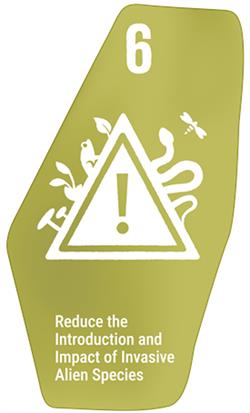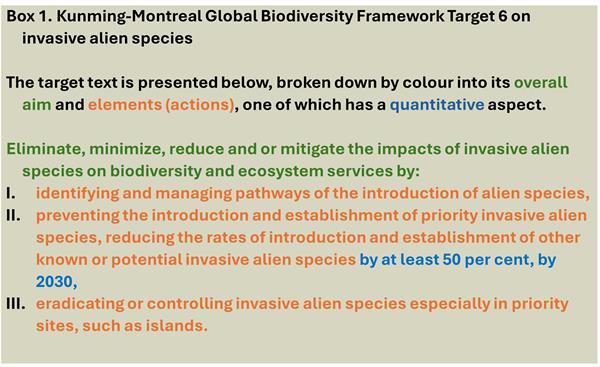Target 6 on Invasive Alien Species


Invasive alien species are one of the main direct drivers of biodiversity loss. In some ecosystems, such as islands, invasive alien species are the leading cause of biodiversity decline. Invasive alien species affect biodiversity by competing with native species for resources, by direct predation or by introducing pathogens. They also modify the composition and structure of ecosystems, reducing the services they provide. In addition to their environmental impacts, invasive alien species pose a threat to food security, human health and economic activities. Globalization and an associated increase in human-mediated activities, such as international transport, trade and tourism, have made the movement of species beyond natural bio-geographical barriers easier and quicker, by creating new introduction pathways. Due to the wide and crosscutting impacts of invasive alien species, including environmental, economic, health, social and cultural impacts, it is necessary to strengthen collaboration across sectors and government agencies at all levels and areas to ensure that this threat is managed effectively. The
Kunming-Montreal Global Biodiversity Framework (KMGBF) has 23 action-oriented
targets for urgent action over the decade to 2030, of which
Target 6 is focused on invasive alien species:
Eliminate, minimize, reduce and or mitigate the impacts of invasive alien species on biodiversity and ecosystem services by identifying and managing pathways of the introduction of alien species, preventing the introduction and establishment of priority invasive alien species, reducing the rates of introduction and establishment of other known or potential invasive alien species by at least 50 per cent, by 2030, eradicating or controlling invasive alien species especially in priority sites, such as islands.
Target 6 can be broken down into the overall aim, and three separate elements or actions (see Box 1 ).

The first two elements aim at addressing impacts from new invasive alien species, through the management of pathways of introduction, and by preventing the introduction and establishment of invasive alien species. The types of actions that will support these elements include border security, legislation, surveillance, and early detection and rapid response. The target requires that priority invasive alien species are prevented from introduction and establishment, but the species classed as a ‘priority’ are to be determined at a national level. This could include species that are likely to have the greatest impacts upon biodiversity if they were to become established.
The quantitative aspect of the target relates to the rates of introduction and establishment for other (i.e. non-priority) invasive alien species, which need to be reduced by 50% by 2030. To achieve these elements of the target, the pathways of introduction will need to be identified and prioritized so that resources are focused on addressing the pathways that are the most important. In addition, the quantitative aspect of the target will require an understanding of the existing or baseline rate of introductions and establishments within the country, and for surveillance and monitoring to be undertaken to identify and record new introductions and establishments.
The third element of the target aims to address impacts from those invasive alien species that are already established within a territory. It requires the eradication or control of invasive alien species, especially in priority sites such as islands. The identification and determination of priority sites is to be done at a national level but could include those that are important for biodiversity and ecosystem services and vulnerable to, or are facing significant impacts from, invasive alien species. Invasive alien species that are currently having the greatest impact, or may do so in the near future (e.g. due to climate change or other drivers of change), should be prioritized for eradication. Where this is not feasible, their populations should be contained and controlled so that their impacts are mitigated.
How to support target implementation?
-
Alien Species’ Toolkit for Target 6 of the Kunming-Montreal Global Biodiversity Framework as well as additional resources can be found under the section
Tools to support implementation